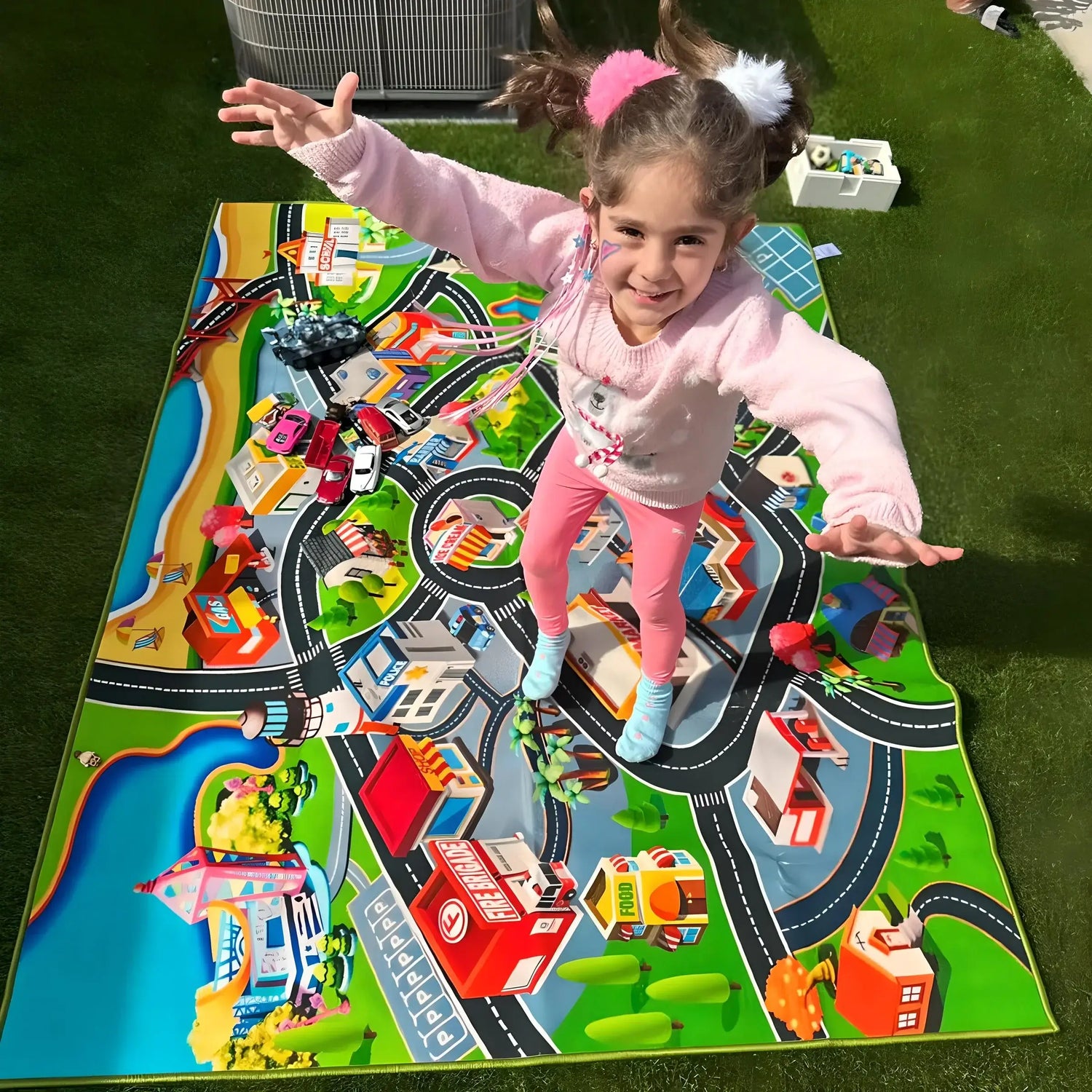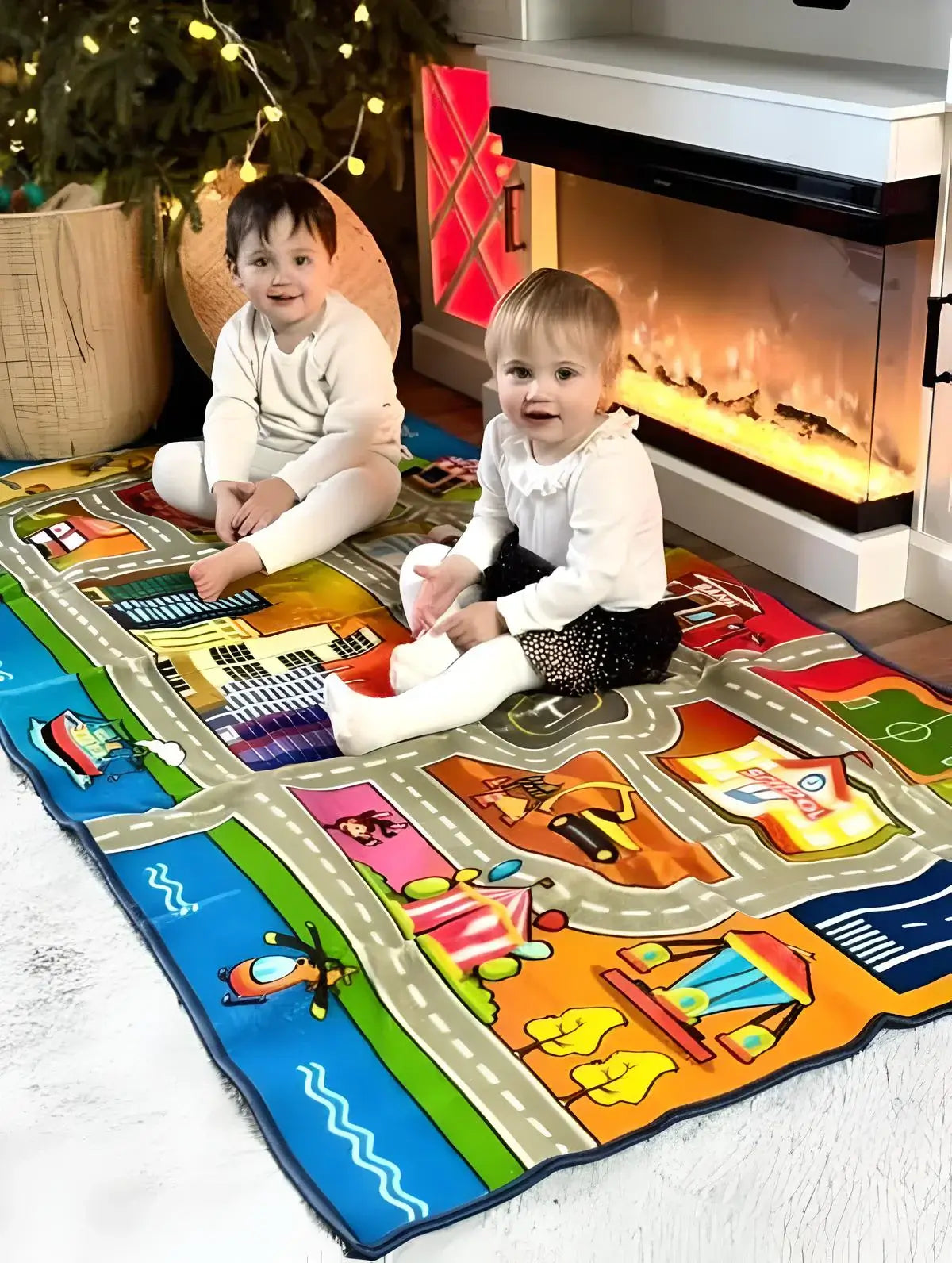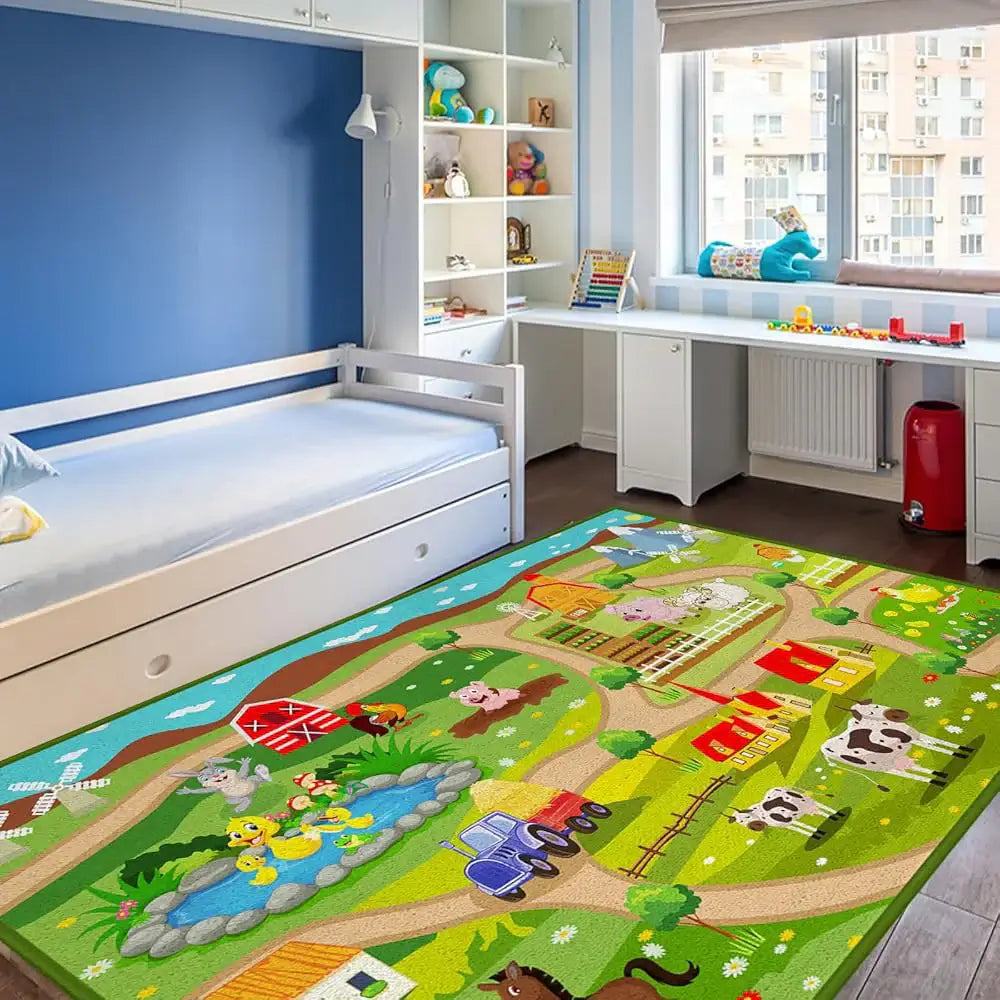Understanding the Montessori Prepared Environment
The Philosophy of Purposeful Design
In Montessori classrooms, nothing is arbitrary. Every material, every piece of furniture, and yes, every rug is selected with intention. The prepared environment should:
- Promote independence and freedom within limits
- Be sized appropriately for children
- Offer beauty, harmony, and order
- Include natural materials and colors
- Support concentration and focused work
Work Rugs: The Foundation of Montessori Learning
The individual work rug is perhaps the most iconic element of Montessori floor work. These rugs serve multiple essential functions:
Defining Personal Workspace
- Creates clear boundaries for individual activities
- Teaches respect for others' work spaces
- Provides a consistent, portable work surface
- Helps children organize their materials
Supporting Concentration
- Minimizes distractions by creating visual boundaries
- Provides comfort for extended floor work
- Allows for full-body engagement with materials
- Creates a sense of ownership and responsibility
Essential Characteristics of Montessori Rugs
Size and Portability
According to Montessori classroom design experts, work rugs should be:
- Small enough for children to carry independently
- Large enough to contain materials without crowding
- Lightweight yet durable
- Easy to roll and store
Typical Dimensions:
- Individual work rugs: 2' x 3' or 3' x 4'
- Small group rugs: 4' x 6'
- Circle time rugs: 6' x 9' or larger
Material Selection
Natural Fibers Preferred
- Wool: Durable, naturally stain-resistant
- Cotton: Washable, soft, affordable
- Jute: Textured, sustainable, defines space well
Why Natural Materials Matter Research on biophilic design in education shows that natural materials:
- Connect children to the natural world
- Provide authentic sensory experiences
- Support environmental awareness
- Create calming, grounded atmospheres
Color Considerations
Neutral and Natural Tones Montessori environments typically feature:
- Beige, cream, and natural wood tones
- Soft earth colors
- Minimal patterns or designs
- Solid colors that don't compete with materials
This restraint in color serves to:
- Highlight the learning materials
- Reduce visual overstimulation
- Create a calm, focused atmosphere
- Allow children's work to be the focal point
Types of Rugs in Montessori Spaces
Individual Work Mats
Small personal rugs that children select, carry, and arrange themselves:
- Stored in accessible baskets or shelves
- Available in multiple identical options
- Cleaned and maintained by children
- Replaced when worn
Line Time/Circle Rugs
Larger rugs for group activities featuring:
- Simple geometric shapes (circles, ellipses)
- Clear boundaries for gathering
- Enough space for comfortable seating
- Minimal decorative elements
Practical Life Area Rugs
Specialized rugs for specific activities:
- Water work areas (waterproof backing)
- Food preparation zones (easy to clean)
- Plant care stations (moisture-resistant)
- Art areas (stain-resistant materials)
Supporting Key Montessori Principles Through Rug Design
Independence and Self-Direction
Well-chosen rugs support independence by being:
- Manageable for small hands
- Easy to clean with child-sized tools
- Simple to roll and store properly
- Clearly designated for specific purposes
Order and Organization
According to child development research, children have a strong need for order. Rugs support this by:
- Having designated storage locations
- Following consistent use patterns
- Maintaining clean, well-kept appearances
- Providing predictable work surfaces
Movement and Sensory Development
Gross Motor Skills
- Carrying and unrolling rugs
- Walking carefully around others' work
- Sitting and rising gracefully
- Maintaining balance while working
Fine Motor Skills
- Rolling rugs tightly
- Arranging materials within boundaries
- Cleaning and maintaining rugs
- Precise placement of work
Creating Distinct Learning Areas
Language Area Rugs
Features that support literacy:
- Soft textures for comfortable reading
- Adequate size for book display
- Neutral colors to showcase materials
- Defined spaces for individual work
Mathematics Zone
Educational pattern rugs can include:
- Subtle grid patterns for counting
- Geometric shapes for exploration
- Clear boundaries for material organization
- Space for manipulative work
Cultural Studies Spaces
Rugs that support global learning:
- Map designs (when educationally appropriate)
- Natural fibers from different cultures
- Simple designs that don't stereotype
- Adequate space for artifact display
The Role of Beauty in Montessori Environments
Aesthetic Education
Maria Montessori believed that children naturally appreciate beauty. Research from aesthetic education studies confirms that beautiful environments:
- Increase engagement and focus
- Develop aesthetic appreciation
- Promote care and respect for materials
- Support emotional well-being
Selecting Beautiful Yet Functional Rugs
- High-quality materials that age gracefully
- Simple, elegant designs
- Harmonious color palettes
- Textures that invite touch
Practical Implementation Tips
Starting a Montessori-Inspired Space
Begin Simply
- Start with a few high-quality work rugs
- Observe how children use them
- Add additional rugs based on needs
- Maintain consistency in style and quality
Storage Solutions
- Open shelving at child height
- Baskets for rolled rugs
- Clear labeling systems
- Easy access for independent use
Maintenance and Care
Child-Led Cleaning Teaching children to care for rugs:
- Daily shaking outside
- Weekly vacuuming with child-sized tools
- Spot cleaning spills immediately
- Rotating rugs to prevent wear
Adult Responsibilities
- Deep cleaning periodically
- Checking for safety issues
- Replacing worn rugs
- Modeling proper care
Adapting Montessori Principles for Different Settings
Home Environments
Parents can incorporate Montessori rug principles by:
- Designating specific work rugs
- Creating defined activity spaces
- Allowing children to choose work locations
- Maintaining order and beauty
Traditional Classrooms
Teachers can add Montessori elements through:
- Portable work rugs for centers
- Defined floor work areas
- Student choice in seating
- Natural, calming colors
Common Misconceptions
"Montessori Means Minimalist"
While Montessori emphasizes simplicity, it doesn't mean sterile. According to Montessori training organizations, environments should be:
- Rich in learning opportunities
- Warm and inviting
- Carefully curated, not empty
- Responsive to children's needs
"Any Rug Will Do"
Quality matters in Montessori environments because:
- Children deserve beautiful materials
- Durability supports repeated use
- Natural materials provide authentic experiences
- Well-made items teach care and respect
Budget-Friendly Montessori Rug Solutions
Prioritizing Purchases
- Invest in quality work mats first
- Add specialty rugs gradually
- Choose neutral colors for longevity
- Buy in sets for consistency
DIY Options
While purchasing quality rugs is ideal, alternatives include:
- Repurposing yoga mats (temporary solution)
- Using fabric remnants for light work
- Creating simple cloth mats
- Seeking donations from families
Assessment Through Environmental Observation
Signs of Effective Rug Use
- Children independently selecting rugs
- Defined work spaces throughout room
- Careful movement around others' work
- Pride in maintaining materials
- Extended concentration periods
Adjusting Based on Observation
If children aren't using rugs effectively, consider:
- Rug size and weight appropriateness
- Storage accessibility
- Modeling and lessons needed
- Environmental obstacles
The Long-Term Impact
Building Life Skills
Through proper rug use, children develop:
- Spatial awareness and planning
- Respect for materials and space
- Independence and self-direction
- Care for their environment
- Concentration and focus
Creating Lifelong Learners
Research on Montessori outcomes shows that students develop:
- Strong executive function skills
- Independent learning abilities
- Respect for their environment
- Collaborative work skills
- Self-motivation
Conclusion: More Than Just Floor Coverings
In Montessori-inspired classrooms, rugs are far more than decorative elements or comfortable surfaces. They are essential tools that support independence, define learning spaces, and create the prepared environment where children can reach their full potential. By understanding and implementing these principles—whether in a full Montessori classroom or a Montessori-inspired space—we provide children with the foundation they need for concentrated work, respectful collaboration, and joyful learning.
The beauty of the Montessori approach lies in its recognition that children are capable, creative individuals who deserve environments that honor their developmental needs. When we select rugs with the same care we give to other learning materials, we send a clear message: every aspect of your learning environment has been prepared with love, intention, and respect for your journey of discovery.




Leave a comment
This site is protected by hCaptcha and the hCaptcha Privacy Policy and Terms of Service apply.